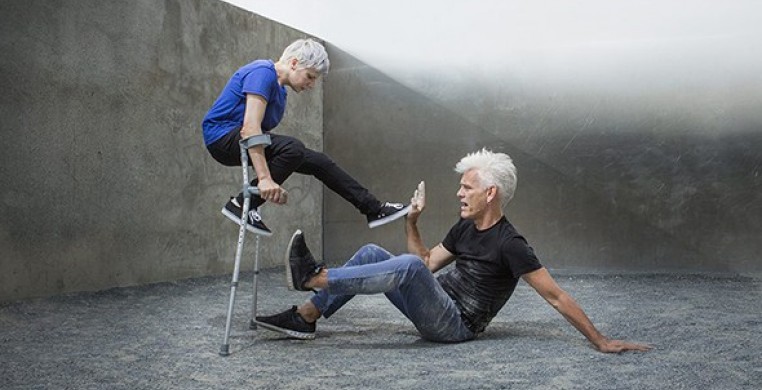An ever-expanding definition of dance increasingly includes people with disabilities, and there are an array of interpretations and opinions which surround the topic of integrated dance. Some argue that the aesthetic of prescribed dance traditions should be expanded to include disabled bodies, as seen, for example, in a gaggle of professional dance companies incorporating wheelchair users with “standing dancers.” Others, including Glasgow-based multidisciplinary artist Claire Cunningham, reject conventional dance techniques altogether, in order to discover disabled bodies’ inherent physicality and capacity for movement independent from codified concert dance forms.
Less explored is how to invite people with physical, sensory, and cognitive differences into performance spaces and create accessible environments in which everyone can enjoy dance of all kinds. In addressing this curiosity, Cunningham and Jess Curtis carefully crafted “The Way You look (at me) Tonight,” which toured to the Museum of Contemporary Art Chicago last weekend.
Watching a Dance show – capital D – can be a two-dimensional experience, though many artists break the fourth wall, inviting audience members into multi-dimensional, participatory experiences. At these sorts of performances, you can be, and often are, more exposed than when in conventional theater seating. Dance is confusing to the average user, and some of us (ok, me) are self-deprecatingly shy when we realize we are the ones being watched, removing all sense of joy and wonder for the work in an effort to not look dumb.
“The Way You Look (at me) Tonight,” however, feels like a three-dimensional hug, designed to have multiple points of entry inviting the audience into the work. A brightly colored glow stick mobile , strung from the rafters , partially obstructs projection screens hung on three sides of the stage. Each screen, at the show’s onset, displays white parallel lines in a stunning video designed by Yoann Trellu. The inference might be some sort of transmission or communication device – old-timey video clips of Fred Astaire and Ginger Rodgers fuzz in and out, along with images of Cunningham and Curtis’ “philosophical consultant,” Alva Noe, speaking about the nature of choreography and its relationship to dance, the body, and identity.
And this seems to be the primary point, though it takes a long time to get there. Most of the audience is seated onstage in a conch-like pattern, which, at regular intervals, obstructs the performers from view. But as part of the lengthy list of disclaimers and disclosures at the top of the show, I’m led to believe that this, too, is part of the point. Cunningham and Curtis take a long time to manage the expectations of the audience, giving them permission to leave, and letting them know about each of the multiple sensory inputs aimed at increasing audience accessibility. There is a chance you will be touched by the performers, or invited to do push-ups (few in our group bit at this opportunity); supertitles provide a supplement to some sections of recorded audio, with a Sunday matinee including ASL interpretation for people with hearing impairment; and visually-impaired audience members could supplement their performance with an audio description headset describing the physical action onstage.
Cunningham uses crutches, and for much of the performance, so does Curtis, an experimental dancer and choreographer based in California who is grappling with an aging body and a new titanium hip in his movement explorations. Together the two explore the intersections between injury and disability, leading to an exercise on gaze – quite literally, about the way we look at individuals with physical differences.
In public, Cunningham said she notices with her peripheral vision how others stare at her, but then would turn their heads if she looked directly at them. Conversely, Curtis observed increased eye contact from women during periods in which he was injured, as though somehow, as a man, the perception of a physical limitation made him less threatening. Instructed by Curtis and Cunningham to practice viewing their movements through our peripheral vision, I considered my own curiosity toward bodies that aren’t like mine, conflicted by societal mores around staring at people and “minding my manners.”
In performance, however, we are invited to view others’ bodies and extract meaning from those observations. Moreover, “The Way You Look (at me) Tonight” co-mingles casual, but revelatory, dialog on how age, ability, gender and sexuality intersect with identity alongside “performed” elements: a tutorial on the movement vocabulary Cunningham learned from “Crutch Master” Bill Shannon, Curtis’s exploration of his new hip in a solo titled “F*&k Off, Peripheral Hip-stir,” a contact improv duet, Cunningham’s singing a Scottish hymn atop a huge A-frame ladder, and a dance almost completely in the dark.
It might feel a bit odd to have left this multi-sensory performance experience, which contains so little of one might call “dance,” and say you’ve gone to a dance concert, but this only goes to show how limiting the perceptions of dance can be.
It doesn’t hurt that they’re both super charming, but a whole lot of this 100-minute performance is walking and talking, managing our perceptions of the work in precise ways and essentially providing a “how-to” guide for contemporary dance. In some ways, this stripping away of dance’s inherent obfuscation is wholly refreshing, but part (most) of the joy of witnessing movement-based performance is the abstraction, the not-knowing, the muddled meanings and discordance of opinions, and the excitement of the challenge. Despite the depth and complexity of the subject matter, I came away from “The Way You Look,” feeling like I got it – nailed it! For some reason, that feels disappointing; there’s some magic in the mystery of dance that feels lost in this case.
Lauren Warnecke is the Dance Writer/Critic for the Chicago Tribune.

